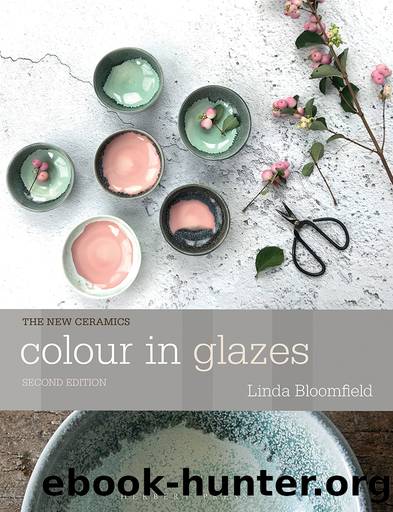Colour in Glazes by Bloomfield Linda;

Author:Bloomfield, Linda;
Language: eng
Format: epub
Publisher: Bloomsbury Publishing Plc
Published: 2021-09-15T00:00:00+00:00
* * *
3 In industry, the biscuit firing is to a higher temperature than the glaze or glost firing.
Pink glazes
The usual way to produce pink in glazes is to use chromium and tin, or a pink stain which is likely to contain the same materials, together with calcium and silica. Around 0.1% chromium and 5% tin oxide will produce pink in glazes that are high in calcium (more than 15% whiting or 0.7 calcium in the unity molecular formula) and that contain no zinc oxide or magnesia. The boron content should not be too high â no more than a third of the calcium content. The colour depends on the ratio of chrome to tin: 1:25 gives pink, 1:20 gives maroon and 1:5 gives green. Chromium is volatile at high temperatures and will cause pink flashing on tin-opacified pots nearby in the kiln. To avoid this, white glazes can be opacified with zirconium silicate and should also contain no zinc, which turns brown in the presence of chromium. However, in high zinc, high-alumina glazes (0.4-0.7 ZnO and 0.4 Al2O3 in UMF) a pink colour will form with 1% chromium oxide. Chrome-tin pinks should be fired to temperatures below 1260°C (2300°F/cone 8); otherwise, the colour evaporates. To avoid this, the kiln can be fired slowly to around 1240°C (2822°F) and held for 15 to 30 minutes to soak. Chrome-tin pinks are only possible in oxidation, but copper oxide can produce a pink colour in reducing conditions.
Recipe for chrome-tin pink underglaze (19th century) (from Pottery Gazette, London, 1880s, Smith, Greenwood & Co)
Tin oxide 40 lbs
Whiting 20 lbs
Chrome oxide 1.5 lbs
Download
This site does not store any files on its server. We only index and link to content provided by other sites. Please contact the content providers to delete copyright contents if any and email us, we'll remove relevant links or contents immediately.
Technical Art History by Jehane Ragai(443)
Art, Science, and the Natural World in the Ancient Mediterranean, 300 BC to AD 100 by JOSHUA J. THOMAS(399)
Graphic Culture by Lerner Jillian;(391)
The Slavic Myths by Noah Charney(360)
Pollak's Arm by Hans von Trotha(331)
Simply Artificial Intelligence by Dorling Kindersley(330)
Treasuring the Gaze by Hanneke Grootenboer(330)
The Art of Portrait Drawing by Cuong i(324)
Sketchbook Confidential: Secrets from the private sketches of over 40 master artists by Editors of North Light Books(324)
Drawing for the Soul by Zoë Ingram(318)
Drawing Landscapes by Barrington Barber(312)
The Art of Painting Sea Life in Watercolor by Maury Aaseng Hailey E. Herrera Louise De Masi and Ronald Pratt(301)
Mountain Manâs Field Guide to Grammar by Gary Spina(299)
Portrait of a Woman by Bridget Quinn(288)
A text-book of the history of painting by Van Dyke John Charles 1856-1932(280)
Anatomy for the Artist by Jennifer Crouch(279)
Preparing Dinosaurs by Wylie Caitlin Donahue;(274)
Botanical Illustration by Valerie Price(271)
Egyptian art by Jean Capart(266)
